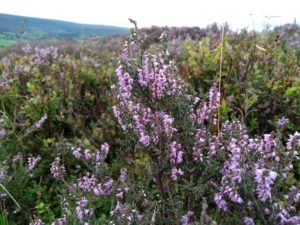If you’ve been to the moors recently (or been lucky enough to take a holiday to Scotland) you’ve probably noticed that the heather is in full bloom!
Once considered an indicator of the harshest type of rural poverty, Calluna vulgaris was made popular by Queen Victoria’s love of the Scottish Highlands. In Scotland, white heather is considered to bring good luck (rather like four leaf clovers for the Irish) so several white flowering cultivators have been developed, although wild heather is most commonly a light purple.


Growth conditions:
It is the only species in the genus Calluna and generally considered one of the toughest plants going, surviving severe exposure, temperatures below -20 °C and burning. However it requires acidic soils (pH 4.5-6.0) to grow and so often doesn’t do well in cultivation. The pH of the soil a plant grows in is important because it affects a wide range of factors, including which bacteria are present and the availability of certain nutrients such as nitrogen. Some soils can also change their structure in different pH’s; a classic example is clay, which is granular and perfectly suited to many crops in the pH range of 5.5-7.0 but at either extreme becomes very sticky and tends to suffocate roots.
The curious properties of heather honey:
As well as being beautiful, heather is a fantastic source of nectar for honey bees. The honey produced by them was once dismissed as unwholesome by the Greek physician, Dioscurides but today it is very popular. It shares an interesting characteristic with tomato ketchup- both are thixotropic fluids. This means that they decrease in viscosity with time for a constant applied shear stress and then gradually return to the original state when the stress is removed. The honey is jelly like until it is stirred and will return to a jelly when the stirring stops, as you can imagine, this makes it very difficult to extract from the honeycomb!

The heather has another surprise in its nectar, one that could be vital in helping to save wild bee colonies. It has recently been found that a chemical called callunene (present in the nectar) can help to treat a common gut parasite, Crithidia bombi, and help protect the bees from catching it in the first place, by preventing flagellar anchoring to the ileum epithelium. Boosting heathland conservation would increase bees’ access to heather, hopefully improving the health of wild colonies. It is also possible that this might be the compound which is responsible for heather’s use in herbal medicine to treat urinary tract infections, although this has yet to be investigated.
Can I make alcohol from it? The important questions in life:
Something you may not have associated this plant with immediately is beer. However heather has been used as a bittering herb (alongside myrtle and broom) in Scottish beer since at least 1769 when Thomas Pennet wrote in A tour in Scotland that on the island of Islay “ale is frequently mixed with the young tops of heath…” Brewing history in Scotland dates back 5,000 yrs so it’s safe to assume this tradition is likely a lot older than Pennet’s book. Beer produced with this mix of herbs is called gruit beer and it can still be found today, although hop beers have largely replaced it because hops tend to be cheaper and do a better job of preserving the beer. February 1st is the official International Gruit Day in case you can find some to try!
